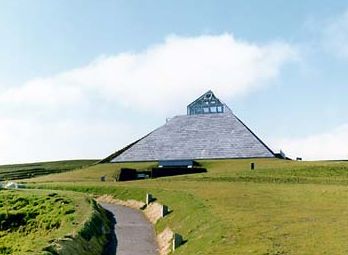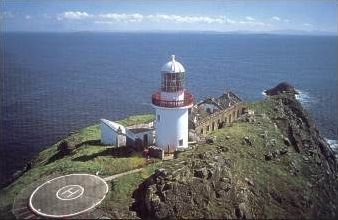More info...

Drom_Caoin_Bed_Breakfast_Belmullet
               
|
| |
|
|
| Explore Our Anicient Land |
 |
| |
|
|
|
|
| |
|
|
| |
|

This is an ancient land where many fables and legends were written. Evidence of man's existence on this fossilised landscape dates back before 3,000 BC.
The land is dotted with Megalithic tombs from neolithic times, Iron Age cliff forts, sites of castles from the 16th, 17th, and 18th centuries with the well documented arrival of the Spanish Armada off Blacksod Bay in 1588.
|
Céide Fields
 The Céide Fields, Ballycastle are the oldest known field systems in the world, over five and a half millennia old. The Céide Fields, Ballycastle are the oldest known field systems in the world, over five and a half millennia old.
It is a unique Neolithic landscape of world importance, which has changed our perception of our Stone Age ancestors.
The remains of stone field walls, houses and megalithic tombs are preserved beneath a blanket of peat over several square miles. They tell a story of the everyday lives of a farming people, their organized society, their highly developed spiritual beliefs, and their struggle against a changing environment beyond their control.
Visit the multi-award winning Céide Fields Interpretative Centre, which has exhibitions, audio-visual show and tearooms.
|
Our Boglands
The main soil type of Erris is peat. When the ice from the last ice age melted (10,000 years ago) shallow lakes and pools were formed. Plants started to grow in the lakes and when the plants died they fell down to the bottom of the lake and a layer of dead plants built up as peat. This peat eventually filled up the lakes. In this way blanket bog was formed. Its formation was helped by heavy rainfall; this prevents the soil from drying out but also washes away any nutrients that are in the soil. As a result boglands are very low in nutrients and only special plants can grow.
The main plant of the bog is Sphagnum Moss. This plant is sometimes known as the Bogbuilder as the development of the bogs and the growth of other plants depend on the moss. Some of these plants are Cross Leaved Heath (a type of heather), Ling Heather, Bog Asphodel, Bog Pimpernel, Bog Bean, Purple Moor Grass and Dear Sedge.
Some bog plants have interesting features; the Sundew and the Bladderwort are insectivorous plants. This means that they get extra nutrients by trapping and digesting insects. Some bogland plants are endangered species as, due to drainage, their natural habitat is changing. These plants cannot survive in drier soils.
Flora is abundant and there are varieties found here originating in the Arctic, South West Europe and North America.
This living, breathing, unspoilt bogland is the largest in Europe and teeming with wildlife.
While in Erris, visit Céide Fields to see an interpretation of the development of the bogs over the many millennia.
|
The Islands
 Off the coast to the west lie the beautiful and tranquil islands of Inis Glora, Dubh Oileán Mór, Inishkea North and Inishkea south, all of which are steeped in history and where monasteries flourished in Early Christian Times. Off the coast to the west lie the beautiful and tranquil islands of Inis Glora, Dubh Oileán Mór, Inishkea North and Inishkea south, all of which are steeped in history and where monasteries flourished in Early Christian Times.
St. Brendan the Navigator had strong links with Inis Glora and the remains of the monastic settlement which he founded can still be seen today.
According to legend the latter is said to be the final resting place of the Children of Lir.
Read the legend
The Inishkeas were home to a thriving fishing community until disaster struck on 28th October 1927. Ten fishermen were lost at sea on that fateful night and were subsequently buried at Fál Mór. There were two survivors. The islands were deserted shortly thereafter.
 These islands have a wealth of historical and archaeological material. St. Colmcille founded a monastery on Inishkea North, in the Early Christian Period and a purple ink which was used to illuminate the manuscripts was exported from here to other monastic sites. These islands have a wealth of historical and archaeological material. St. Colmcille founded a monastery on Inishkea North, in the Early Christian Period and a purple ink which was used to illuminate the manuscripts was exported from here to other monastic sites.
Rusheen, a tidal island to the east of Inishkea South was once the site of a whaling station, the remains of which are still evident today. This was set up by the Norwegians in 1907.
The Inishkeas are internationally important with respect to birdlife. Half of the Irish wintering population of Barnacle geese make the islands their home.
Trips to Islands Arranged on Request.
|
The Spanish Armada
 Many tragic stories still live vividly in the folk memory of local inhabitants. The dramatic arrival of the Spanish is well documented. Between twenty and twenty-four Spanish Armada vessels perished on the West Coast of Ireland in the winter of 1588. Many tragic stories still live vividly in the folk memory of local inhabitants. The dramatic arrival of the Spanish is well documented. Between twenty and twenty-four Spanish Armada vessels perished on the West Coast of Ireland in the winter of 1588.
The storm damaged Armada merchant ship, the Sancta Maria Rata Encoronada (820 tons), limped into Blacksod Bay. The Rata under the command of Don Alonso de Levia, a favourite of King Philip, anchored off Fahey Bay. A landing party was set ashore to seek fresh water and was captured by Richard Burke, the local chieftain, known as Corráin an Diabhail, (the Devil's Hook). The following day a storm blew the Rata ashore at Fahey in Ballycroy.
The 450 Spanish survivors took refuge in deserted Doona Castle nearby and burned the abandoned ship. Another Spanish vessel was wrecked in Broadhaven at the same time and all the survivors joined up and were taken by the Duqesa Santa Ana, which accompanied the Rata. Sadly their luck ran out, she headed north for Scotland fearing the winter crossing of the Bay of Biscay and was wrecked in Loughros Bay, County Donegal.
With the help of the McSweeneys they repaired another Spanish ship, the Girona, which was also blown into Donegal Bay. As they sailed for Scotland the Girona was wrecked at Dunluce in Antrim; Don Alonso was buried with two hundred and sixty other souls near the Giant's Causeway.
|
|
back to top ^
|
|
| |
|
|
|
|


















